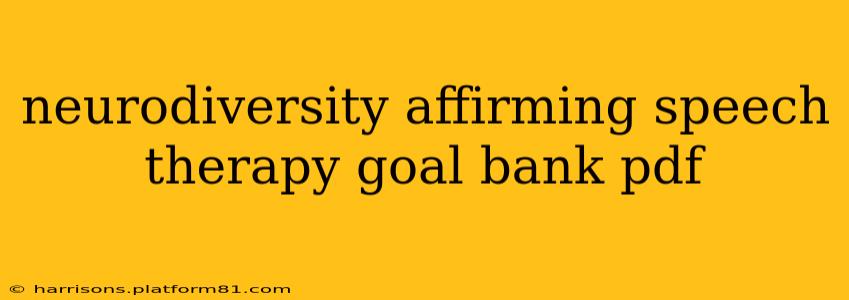Neurodiversity-Affirming Speech Therapy Goal Bank: A Comprehensive Guide
Finding the right words to describe goals in speech therapy for neurodivergent individuals can be challenging. This guide aims to provide a comprehensive and neurodiversity-affirming goal bank, focusing on celebrating strengths and addressing challenges respectfully. We'll move beyond traditional deficit-based language and explore strategies that empower and affirm the unique communication styles of autistic and other neurodivergent clients.
What is Neurodiversity-Affirming Speech Therapy?
Neurodiversity-affirming speech therapy recognizes that neurological differences, such as those found in autism spectrum disorder (ASD), attention-deficit/hyperactivity disorder (ADHD), and others, are natural variations in human neurology. It shifts the focus from "fixing" differences to understanding and supporting individuals' unique communication needs and preferences. This approach emphasizes celebrating strengths, fostering self-advocacy, and promoting communication in ways that align with the individual's neurotype.
Key Principles of a Neurodiversity-Affirming Approach:
- Strengths-based: Focusing on the individual's communicative strengths and building upon them.
- Individualized: Tailoring therapy to meet the unique needs and preferences of each client.
- Person-first language: Using person-first language (e.g., "person with autism" instead of "autistic person") unless the individual prefers identity-first language. Always respect the individual's preference.
- Collaboration: Working collaboratively with the client, family, and other professionals.
- Respectful and empowering: Creating a safe and supportive environment where clients feel respected and empowered.
Goal Areas & Examples:
This section will provide examples of neurodiversity-affirming goals across various areas of speech therapy. Remember, these are examples and should be adapted to fit the individual client's needs and preferences. Always consult with the client and their family to ensure goals are meaningful and achievable.
1. Social Communication:
- Goal: Increase the client's ability to initiate conversations in preferred social situations, using socially appropriate language and nonverbal cues, measured by observations during naturalistic interaction and self-report. (Note the use of measurable outcomes and client preference integration.)
- Goal: Improve understanding of nonverbal communication, including body language and facial expressions, through role-playing activities and social stories.
- Goal: Develop skills in understanding and responding to different communication styles, fostering tolerance and respect for diverse communication approaches.
2. Pragmatics (Social Use of Language):
- Goal: Increase the client's ability to appropriately interpret and respond to sarcasm and humor in context, with successful responses observed in at least 80% of conversational attempts.
- Goal: Improve the client’s ability to understand and respond to subtle cues in conversation, including changes in tone and nonverbal communication, evidenced by successful participation in interactive games and conversations.
- Goal: Develop strategies to manage sensory overload during social interactions, reducing anxiety and improving communication participation through sensory regulation techniques.
3. Articulation & Phonology:
- Goal: Improve accuracy of specific sounds in spoken words with a focus on targeted sounds deemed important by the client.
- Goal: Increase the client's comfort and confidence using a communication aid or AAC system. (Augmentative and Alternative Communication systems should be a considered part of therapy when appropriate.)
4. Language Comprehension:
- Goal: Improve understanding of complex sentences and instructions by providing multiple modalities of instruction and allowing time for processing.
- Goal: Develop strategies for interpreting and comprehending abstract concepts and idioms, focusing on context-based understanding and providing visual supports as needed.
5. Fluency:
- Goal: Reduce the frequency of speech disfluencies through a combination of techniques chosen by the client, monitored through audio recordings and therapy sessions.
- Goal: Improve the client's ability to self-monitor and manage speech disfluencies.
Important Considerations:
- Individualized Education Programs (IEPs) and 504 Plans: These plans should always inform the creation of goals and objectives.
- Collaboration with Families: Families are vital partners in therapy. Collaborate with parents/guardians to ensure goals are aligned with their values and expectations.
- Data Collection: Track progress using methods that respect the client's needs and preferences (e.g., observation, audio/video recordings, self-report).
- Flexibility and Adaptability: Goals may need to be adjusted as the client’s needs and preferences change over time.
This goal bank is not exhaustive, but it offers a starting point for developing neurodiversity-affirming goals. Remember to always prioritize the individual client’s needs, preferences, and strengths. The ultimate aim is to empower neurodivergent individuals to communicate effectively and authentically in ways that work best for them. A PDF version of this information may be created by copying and pasting this text into a word processor and saving it as a PDF document.
Disclaimer: This information is for educational purposes only and does not constitute medical advice. Always consult with a qualified speech-language pathologist to develop individualized treatment plans.
